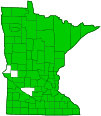nannyberry
(Viburnum lentago)
Conservation • Wetland • Description • Habitat • Ecology • Use • Distribution • Taxonomy
Description |
||
Nannyberry is a moderate growing, short lived, tall shrub with multiple stems or a short tree with a single stem. It rises from scattered, deep, anchoring roots and shallow, branched, fibrous, soil-binding roots. The roots have buds which may sprout and form above-ground stems (suckers). When conditions permit, it forms colonies which may become large and dense. The stems are slender and crooked. They may be up to 26′ tall and up to 6″ in diameter at breast height, but are usually no more than 20′ in height and 3″ in diameter. Twigs are slender, long, flexible, and round or somewhat six-sided. First-year twigs are pale green and covered with downy, rust-colored hairs at first, becoming gray or dull grayish-brown, smooth, and hairless. Second-year twigs are brown to reddish-brown or grayish brown, and may be somewhat covered with a whitish, waxy bloom (glaucous). The twigs have an unpleasant odor when bruised. The pith is white and solid. The leaf scars are narrow, crescent-shaped, and slightly raised. Each leaf scar has three bundle scars. The terminal bud is brownish-gray, hairless, ¾″ to 1¼″ long, oblong cone-shaped, and somewhat flattened, with a swollen, bulbous base and a long, tapered tip. It is covered by two sharply pointed, abutting but not overlapping, sharply-pointed scales. Lateral buds are about half as long, are not swollen at the base, and are often curved. The bark is grayish-brown and smooth at first, becoming rough and shallowly furrowed with irregular, scaly plates on older stems. When broken, the bark has a skunk-like odor. The leaves are opposite, undivided (simple), and deciduous. They are attached to the twig on a ⅝″ to 1¼″ long leaf stalk (petiole). The petiole is channeled on the upper (ventral) side and and has conspicuous wavy wings. It is moderately to densely covered with microscopic, red, star-shaped hairs when young, becoming hairless or nearly hairless at maturity. There are no projecting glands near the attachment of the leaf blade. There are no leaf-like appendages (stipules) at the base of the petiole. The leaf blades are relatively thin, broadly egg-shaped to elliptical or broadly elliptical, 2″ to 4″ long, and 1⅜″ to 2⅜″ wide. They are rounded or broadly tapered at the base and taper to a short, sharp point at the tip with concave sides along the tip. They are pinnately veined. The lateral veins are evenly spaced, curve toward the tip, and form a network with adjacent veins without reaching the margin. The upper surface is dark green or yellowish-green and glossy, with scattered, microscopic, red, star-shaped hairs when young, becoming hairless at maturity. The lower surface is pale green with tiny, dark brown dots. The margins have more than 25 fine, sharp, forward-pointing teeth on each side. The leaves turn red or reddish-purple in the fall. The inflorescence is a dense, rounded, shallowly convex, 2″ to 4″ in diameter, branched cluster (cyme) at the ends of the current-year branches. The cymes have usually 3 to 5, sometimes up to 7, main branches emanating from the tip of the branch. Each cyme has a few hundred to several hundred small flowers. The flowers are ⅛″ to 5⁄16″ in diameter. There are five sepals, five petals, five stamens, and no style. The sepals are green, fused for most of their length into a minute cup (calyx), and separated at the tip into five minute, egg-shaped lobes. The petals are pale yellow to creamy white, egg-shaped to elliptical, and 1 ⁄16″ to ⅛″ long. The stamens have white filaments and bright yellow anthers. They are ⅛″ to 3 ⁄16″ long, longer than the petals. There is a three-lobed, stalkless stigma on a short disk (stylopodium) at the top of the ovary. The flowers on the margin are fertile and are similar in appearance and size to the other flowers. The flowers are not fragrant. They appear in mid-May to early June. The fruit is an edible, juicy, berry-like, ellipse-shaped to nearly spherical, somewhat flattened, 5 ⁄16″ to ⅝″ long drupe. It contains one seed. It is green initially, becoming bluish-black and glaucous at maturity. The calyx and stigma persist in fruit, forming a dried tip at the end (apex) of the drupe. The pedicels turn red as the fruit matures. The fruit ripens in late August to late September, often remaining on the plant through the winter. |
||
Height |
||
8′ to 26′ |
||
Flower Color |
||
Creamy white |
||
Similar Species |
||
American highbush cranberry (Viburnum opulus var. americanum) leaves are 3-lobed. The petiole has 2 to 4 projecting glands near the attachment of the leaf blade. The flowers on the margin of the inflorescence are sterile and have large, conspicuous corollas. Downy arrowwood (Viburnum rafinesqueanum var. rafinesqueanum) petioles are much shorter, ⅛″ to ½″ long, are not winged, and have a pair of stipules at the base. The leaf margins are coarsely toothed with fewer than 15 teeth per side. The lateral veins are straight, not curved, and extend all the way to the margin. The lower leaf surface has patches of woolly hairs in the larger vein axils. The inflorescence is much smaller, only ¾″ to 2⅜″ in diameter; is borne on a pedicel up to 2″ long; and contains fewer than 100 flowers. |
||
Habitat |
||
Moist to moderate moisture. Hardwood forest edges, flood plains, lakeshores, riverbanks, roadsides. Full sun to partial shade. |
||
Ecology |
||
Flowering |
||
Mid-May to early June |
||
Pests and Diseases |
||
|
||
Use |
||
|
||
Distribution |
||||
|
Sources |
|||
| 2/12/2023 | ||||
Nativity |
||||
Native |
||||
Occurrence |
||||
Common |
||||
Taxonomy |
|||
| Kingdom | Plantae (Plants) | ||
| Division | Tracheophyta (Vascular Plants) | ||
| Subdivision | Spermatophytina (Seed Plants) | ||
| Class | Magnoliopsida (Dicots) | ||
Order |
Dipsacales (honeysuckles, moschatels, and allies) | ||
Family |
Viburnaceae (elder) | ||
Genus |
Viburnum (viburnums) | ||
Family Currently (2023), some sources, including USDA PLANTS and NatureServe, place the genera Sambucus and Viburnum in the Caprifoliaceae family. Some sources, including ITIS and NCBI, place them in the Adoxacea family. Almost all other sources, including APG IV, World Flora Online, Plants of the World Online, GRIN, GBIF, and iNaturalist, place the two genera in the Viburnaceae family. |
|||
Subordinate Taxa |
|||
|
|||
Synonyms |
|||
Viburnum × vetteri |
|||
Common Names |
|||
nanny-berry nannyberry sheepberry |
|||
The common name nannyberry refers to the curious fact that nanny goats are more drawn to the fruits than billy goats. Another common name, sheepberry, refers to the odor of overripe fruit, which has been described as the smell of wet wool. |
|||
Glossary
Calyx
The group of outer floral leaves (sepals) below the petals, occasionally forming a tube.
Corolla
A collective name for all of the petals of a flower.
Cyme
A branched, flat-topped or convex flower cluster in which the terminal flower opens first and the outermost flowers open last.
Drupe
A fleshy fruit with a single hard, stone-like core, like a cherry or peach.
Glaucous
Pale green or bluish gray due to a whitish, powdery or waxy film, as on a plum or a grape.
Petiole
On plants: The stalk of a leaf blade or a compound leaf that attaches it to the stem. On ants and wasps: The constricted first one or two segments of the rear part of the body.
Pinnately veined
With the veins arranged like the vanes of a feather; a single prominent midvein extending from the base to the tip and lateral veins originating from several points on each side.
Pith
The spongy cells in the center of the stem.
Simple leaf
A leaf that is not divided into leaflets, though it may be deeply lobed or cleft.
Stipule
A small, leaf-like, scale-like, glandular, or rarely spiny appendage found at the base of a leaf stalk, usually occurring in pairs and usually dropping soon.
Sucker
A basal shoot rising from the roots or from a bud at the base of a shrub or tree.
Winged leaf stalk
A leaf stalk with a leaf-like or membrane-like extension along both sides.
Visitor Photos |
|||||
Share your photo of this plant. |
|||||
| This button not working for you? Simply email us at info@MinnesotaSeasons.com. Attach one or more photos and, if you like, a caption. |
|||||
|
|||||
MinnesotaSeasons.com Photos |
|||||
Plant |
|||||
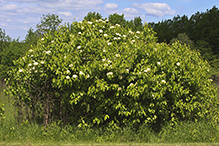 |
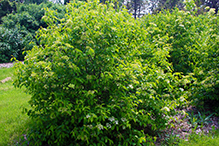 |
||||
Inflorescence |
|||||
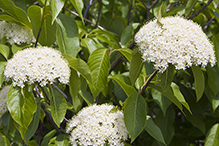 |
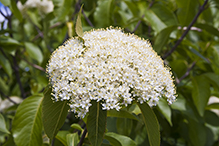 |
||||
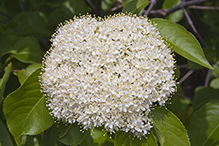 |
|||||
Leaf |
|||||
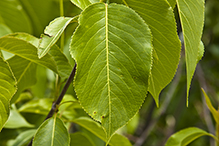 |
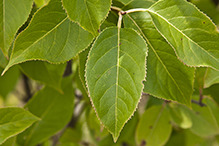 |
||||
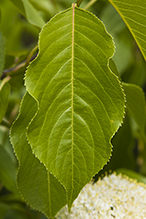 |
|||||
Infructescence |
|||||
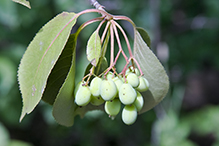 |
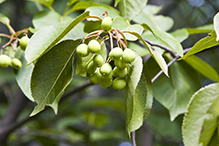 |
||||
 |
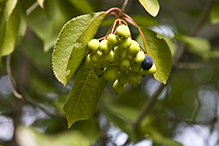 |
||||

Slideshows |
||
| Nannyberry DianesDigitals |
||
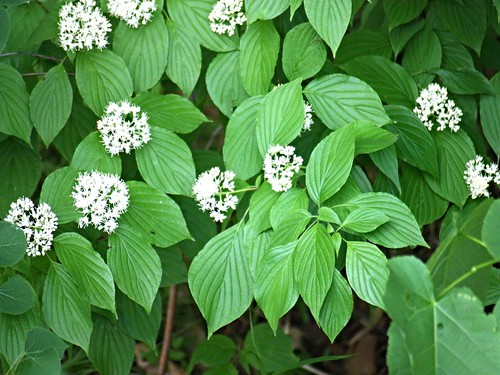
|
||
About
Copyright DianesDigitals |
||
| Fast Growing Vibrumum Lentago Shrubs Plant Nsy |
||
About
Published on Oct 11, 2013 Buy fast gorwing viburnum lentago shrubs For Sale Online $1.40 http://www.treenurseryco.com/nanny-berry/. Buy Nanny Berry Trees at Tree Nursery |
||

Visitor Videos |
|||
Share your video of this plant. |
|||
| This button not working for you? Simply email us at info@MinnesotaSeasons.com. Attach a video, a YouTube link, or a cloud storage link. |
|||
Other Videos |
|||
| Edible and Medicinal Plant - Nannyberry Viburnum lentago MiWilderness |
|||
About
Published on Oct 5, 2012 Please like, share, comment and subscribe. Thanks for subscribing. Thanks for the views, comments, likes and support. This video is about identification and potential use of a closely related group of Viburnums which yield edible berries in the fall of the year and have provided medicine through the ages on several continents throughout the world. Nannyberry Viburnum lentago, Wild Raisin Viburnum cassinoides, and Black Haw Viburnum prunifolium. Other Common Names: Sloe, Stag Bush, Nanny Berry, Sheep Berry, Cramp bark, crampbark. Botanical Plant Family: Caprifoliaceae Honeysuckle Food: Edible berries when ripe. Berries ripen in September and remain through November or later. Ripe berries will be dark blue, sometimes having a white bloom, or film, on them. Nannyberries contain one large flat seed similar in color and shape to a watermelon seed. Berries vary in size and flavor depending upon species. WARNING: SEEK PROFESSIONAL MEDICAL ADVICE BEFORE USING ANY HERBAL REMEDY OR FOLK MEDICINE! All Viburnums are reported to have medicinal properties. Individual species of Viburnums contain varying amounts of the active substances, chemicals and compounds. Viburnin, a bitter glucoside, is one active principle of Viburnums. Herbal and folk medicine: Inner bark is reportedly antispasmodic and relaxes nervous system. Viburnum inner bark has reportedly been used for charley horses, asthma and epilepsy, and for a variety of female troubles including muscle cramps, pregnancy, bleeding and painful menstruation. Some reports suggest Black haw may aggravate tinnitus, ringing in the ears. Harvest time: Viburnum inner bark is best collected in spring when the sap is rising, this makes removal of the bark, and separation of the inner bark easier. Preparation: Viburnum inner bark is typically prepared as a tincture. More tree and shrub use and identification videos from MiWilderness: http://www.youtube.com/watch?v=EnRZog-vvno&list=PL69BBBB171107F34B&feature=view_all More edible, useful or toxic wild plants: http://www.youtube.com/watch?v=bNt0JCWyK7Q&list=PLAB9DFB2A4ED09C68&feature=view_all Tags: Nannyberry Viburnum lentago Wild Raisin Viburum cassinoides Viburnum opulus Black Haw Viburnum prunifolium identification food medicinal use Sloe Stag Bush Nanny Berry Sheep Berry Cramp bark Caprifoliaceae Honeysuckle family "garden harvest" MiWilderness Michigan garden hunt gather forage edible mushroom spore print plant identification how to DIY prepper acorn tannin prepared survival skills bushcraft food preservation cooking pressure canner basics pickle fish gun safety sharpen knife strop ax kit gear review field test outdoor sports camp hike bike canoe tarp tent primitive technology botany naturalist organic herbal remedy folk medicine living history permaculture wildcraft home canning guide homegrown homemade maple syrup evaporator buckskin moccasin wood carving |
|||
| Nannyberry TheCampusTrees |
|||
About
Published on Apr 18, 2014 Jeffrey Johnson, a horticulturist for the University of Minnesota Landscape Arboretum, gives a short overview on the range and habits of Nannyberry (Viburnum lentago) |
|||
| Trees with Don Leopold - nannyberry ESFTV |
|||
About
Published on Jul 27, 2012 No description available. |
|||

Visitor Sightings |
|||||
Report a sighting of this plant. |
|||||
| This button not working for you? Simply email us at info@MinnesotaSeasons.com. Be sure to include a location. |
|||||
|
|||||
MinnesotaSeasons.com Sightings |
|||||

|
Created: Last Updated: © MinnesotaSeasons.com. All rights reserved. |
